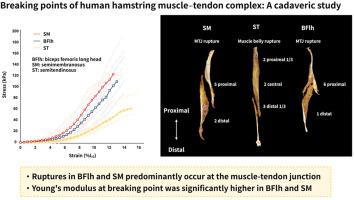人体腘绳肌-肌腱复合体断裂点:尸体研究
IF 3.5
2区 医学
Q2 ENGINEERING, BIOMEDICAL
Journal of the Mechanical Behavior of Biomedical Materials
Pub Date : 2025-08-29
DOI:10.1016/j.jmbbm.2025.107180
引用次数: 0
摘要
腿筋拉伤经常发生在跑步的摇摆后期;然而,人类腘绳肌-肌腱复合物的断裂强度仍不清楚。本研究旨在确定人类腿筋肌肉-肌腱复合物的断裂强度。为此,用蒂尔的方法保存的7具尸体标本进行了检查。分离股骨二头肌长头(BFlh)、半膜肌(SM)和半腱肌(ST)并固定在测试装置上。利用材料试验机,将拉伸载荷(P)施加于每块肌肉的远端。初始肌肉长度定义为松弛长度(L),拉伸过程中记录位移(ΔL)。采用超声测量肌肉腹部横截面积(A)。被动拉伸肌肉直至失效,计算应变(%,ΔL/L)、应力(kPa, P/A)和杨氏模量(kPa,应力/应变)。断裂点被定义为应力趋于稳定而应变继续增加的屈服点。BFlh组的断裂应变(12.7±0.9%)和SM组的断裂应变(12.1±0.8%)显著低于ST组(14.1±1.1%)。BFlh组(106.5±32.2 kPa)和SM组(121.5±23.4 kPa)的断裂应力显著高于ST组(57.3±15.9 kPa) (P < 0.001)。断裂点杨氏模量在BFlh(830.1±216.2 kPa)和SM(992.9±147.9 kPa)显著高于ST(402.4±92.5 kPa)。与ST相比,BFlh和SM表现出更低的断裂应变和更高的断裂应力,表现出更硬的力学性能。这些机械特性可以部分解释为什么这些肌肉在高拉伸载荷条件下更容易受到拉伸。本文章由计算机程序翻译,如有差异,请以英文原文为准。

Breaking points of human hamstring muscle–tendon complex: A cadaveric study
Hamstring strain injuries frequently occur during the late swing phase of running; however, the breaking strength of the human hamstring muscle-tendon complexes remains unclear. This study aimed to determine the breaking strength of human hamstring muscle-tendon complexes. To this end, seven cadaveric specimens preserved using the Thiel's method were examined. The biceps femoris long head (BFlh), semimembranosus (SM), and semitendinosus (ST) muscles were isolated and secured to a testing apparatus. Using a material testing machine, tensile load (P) was applied to the distal end of each muscle. The initial muscle length was defined as slack length (L) and displacement (ΔL) was recorded during elongation. Cross-sectional area (A) was measured at the muscle belly using ultrasonography. Muscles were passively elongated until failure, and strain (%, ΔL/L), stress (kPa, P/A), and Young's modulus (kPa, stress/strain) were calculated. The breaking point was defined as the yield point where stress plateaued while strain continued to increase. Breaking strain was significantly lower in BFlh (12.7 ± 0.9 %) and SM (12.1 ± 0.8 %) than in ST (14.1 ± 1.1 %). Breaking stress was significantly higher in BFlh (106.5 ± 32.2 kPa) and SM (121.5 ± 23.4 kPa) than in ST (57.3 ± 15.9 kPa) (P < 0.001). Young's modulus at the breaking point was significantly higher in BFlh (830.1 ± 216.2 kPa) and SM (992.9 ± 147.9 kPa) than in ST (402.4 ± 92.5 kPa). BFlh and SM displayed lower breaking strain and higher breaking stress compared to ST, demonstrating stiffer mechanical properties. These mechanical characteristics could partially explain why these muscles are more vulnerable to strain under conditions of high tensile loading.
求助全文
通过发布文献求助,成功后即可免费获取论文全文。
去求助
来源期刊

Journal of the Mechanical Behavior of Biomedical Materials
工程技术-材料科学:生物材料
CiteScore
7.20
自引率
7.70%
发文量
505
审稿时长
46 days
期刊介绍:
The Journal of the Mechanical Behavior of Biomedical Materials is concerned with the mechanical deformation, damage and failure under applied forces, of biological material (at the tissue, cellular and molecular levels) and of biomaterials, i.e. those materials which are designed to mimic or replace biological materials.
The primary focus of the journal is the synthesis of materials science, biology, and medical and dental science. Reports of fundamental scientific investigations are welcome, as are articles concerned with the practical application of materials in medical devices. Both experimental and theoretical work is of interest; theoretical papers will normally include comparison of predictions with experimental data, though we recognize that this may not always be appropriate. The journal also publishes technical notes concerned with emerging experimental or theoretical techniques, letters to the editor and, by invitation, review articles and papers describing existing techniques for the benefit of an interdisciplinary readership.
 求助内容:
求助内容: 应助结果提醒方式:
应助结果提醒方式:


